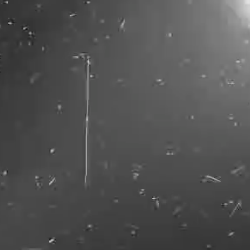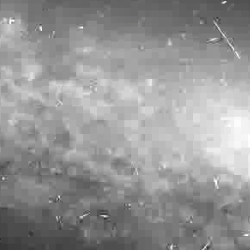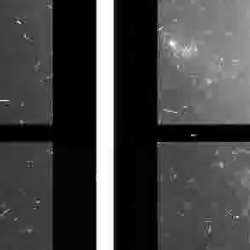Euclid’s goal is to produce scientific insight in the fields of cosmology and astrophysics. New knowledge comes in the shape of understanding of processes, new ‘laws of nature’, or numbers relating different physical properties to each other. However, the Euclid spacecraft initially observes the sky, and its data after a downlink to Earth is processed in a set of complex data analysis pipelines to extract such numbers and relations. Some of the images that have been calibrated to scientific standards that allow such an extraction have already been publicized – but how does Euclid’s raw, unprocessed view into the sky look?
Digital cameras also in phones never show the raw data they observe. And why should they? There would be many instrumental artefacts visible, and especially in current generations of phone cameras the software treatment of the raw detector data is staggering. This is something modern cameras on Earth have very much in common with data observed by Euclid in space: we need to account for a large list of instrumental and detector effects, and correct for them, before the images and spectra that are extracted can be related to absolute physical properties. Each pixel has a slightly different sensitivity. Some might be “hot” or “dead”, meaning they always produce a spurious signal or they produce no signal at all. There is some underlying signal of so-called “dark current” that has to be removed. And then there is the connection of how a certain signal level related to the absolute brightness of the light that hit the detector. And about 50 or so other effect.
For all of these effects the Euclid team has developed a calibration strategy, with frequent calibration observations carried out to at all times know the state of each pixel in both of the two scientific instruments. So is this immediately applied when the VIS or NISP instruments observe the data? No, not initially. In the beginning the data looks like this:
Raw observations of the Euclid VIS camera. Each image is an separate observation of about 10 minutes on the sky.
(Credits: ESA/ Euclid Consortium/ NASA/ K. Kuijken/ J. Brinchmann)
This is what Euclid actually observes – these are examples from the VIS camera in visible light. First, VIS has 36 individual detectors (NISP has 16), and they have boundaries. So what you can see in the video are gaps between chips and often really large galaxies fall on both sides. Sometimes you can even see that there is the edge of the overall field of view, with no data outside of it. Second, there are always cosmic rays hitting the detectors leaving traces of unwanted charges that don’t belong to any galaxy or star in the scene.
While the Euclid pipeline takes care of masking cosmic rays and combining multiple images of the same scene on the sky, slightly shifted and possibly rotated, into the seamless nicely looking images that we enjoy, you can see that this is not at all what Euclid initially observes. Raw data can be quickly inspected for issues, but in the end science requires the complex and accurace data reduction and science analysis pipeline that has been developed for the past decade. And these will also produce nicely looking images that are there for us to enjoy.





